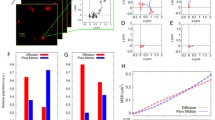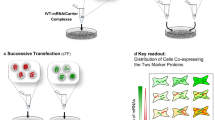Abstract
Polyethylenimine has been used widely in transient gene expression with mammalian cells. To further understand its mediation of gene transfer, the transfection of HEK 293-F cells with dynamically prepared PEI/DNA complexes was studied with the help of fluorescent labeling. The efficiency of complex endocytosis/phagocytosis was found to correlate with the average sizes of complexes applied and complexes greater than 1 μm in diameter were likely excluded by the cells. Coupled with complex growth in size, the degree of association between PEI and DNA increased with the time of complex formation in the presence of competing ions. The blocking of transcription by complex formation necessitated complex dissociation in the nuclear environment for transcription to happen. Intracellularly, the fates of PEI complexed DNA therefore may be mostly determined by the degree of association. Results also suggested that the uptake of PEI/DNA complexes and subsequent protein expression were independent of the cell cycle stages of HEK 293-F cells.







Similar content being viewed by others
References
Ausubel FM, Brent R, Kingston RE, Moore DD, Seidman JG, Smith JA et al (2002) Current protocols in molecular biology. John Wiley & Sons, New Jersey
Backliwal G, Hildinger M, Chenuet S, Wulhfard S, De Jesus M, Wurm FM (2008) Rational vector design and multi-pathway modulation of HEK 293E cells yield recombinant antibody titers exceeding 1 g/l by transient transfection under serum-free conditions. Nucleic Acids Res 36:e96
Baldi L, Muller N, Picasso S, Jacquet R, Girard P, Thanh HP, Derow E, Wurm FM (2005) Transient gene expression in suspension HEK-293 cells: application to large-scale protein production. Biotechnol Prog 21:148–153
Baldi L, Hacker DL, Adam M, Wurm FM (2007) Recombinant protein production by large-scale transient gene expression in mammalian cells: state of the art and future perspectives. Biotechnol Lett 29:677–684
Bertschinger M, Backliwal G, Schertenleib A, Jordan M, Hacker DL, Wurm FM (2006) Disassembly of polyethylenimine-DNA particles in vitro: implications for polyethylenimine-mediated DNA delivery. J Control Release 116:96–104
Boussif O, Lezoualch F, Zanta MA, Mergny MD, Scherman D, Demeneix B, Behr JP (1995) A versatile vector for gene and oligonucleotide transfer into cells in culture and in vivo: polyethylenimine. Proc Natl Acad Sci USA 92:7297–7301
Brunner S, Sauer T, Carotta S, Cotten M, Saltik M, Wagner E (2000) Cell cycle dependence of gene transfer by lipoplex polyplex and recombinant adenovirus. Gene Ther 7:401–407
Brunner S, Furtbauer E, Sauer T, Kursa M, Wagner E (2002) Overcoming the nuclear barrier: cell cycle independent nonviral gene transfer with linear polyethylenimine or electroporation. Mol Ther 5:80–86
Capecchi MR (1980) High efficiency transformation by direct microinjection of DNA into cultured mammalian cells. Cell 22:479–488
Chu YW, Wang R, Schmid I, Sakamoto KM (1999) Analysis with flow cytometry of green fluorescent protein expression in leukemic cells. Cytometry 36:333–339
Derouazi M, Girard P, Van Tilborgh F, Iglesias K, Muller N, Bertschinger M, Wurm FM (2004) Serum-free large-scale transient transfection of CHO cells. Biotechnol Bioeng 87:537–545
Dunlap DD, Maggi A, Soria MR, Monaco L (1997) Nanoscopic structure of DNA condensed for gene delivery. Nucleic Acids Res 25:3095–3101
Forbes DJ (1992) Structure and function of the nuclear-pore complex. Annu Rev Cell Biol 8:495–527
Girard P, Porte L, Berta T, Jordan M, Wurm FM (2001) Calcium phosphate transfection optimization for serum-free suspension culture. Cytotechnology 35:175–180
Girard P, Derouazi M, Baumgartner G, Bourgeois M, Jordan M, Jacko B, Wurm FM (2002) 100-liter transient transfection. Cytotechnology 38:15–21
Godbey WT, Wu KK, Mikos AG (1999) Tracking the intracellular path of poly(ethylenimine)/DNA complexes for gene delivery. Proc Natl Acad Sci USA 96:5177–5181
Grosjean F, Batard P, Jordan M, Wurm FM (2002) S-phase synchronized CHO cells show elevated transfection efficiency and expression using CaPi. Cytotechnology 38:57–62
Grosse S, Thevenot G, Monsigny M, Fajac I (2006) Which mechanism for nuclear import of plasmid DNA complexed with polyethylenimine derivatives? J Gene Med 8:845–851
Han X, Sun L, Fang Q, Li D, Gong X, Wu Y, Yang S, Shen BQ (2007) Transient expression of osteopontin in HEK 293 cells in serum-free culture. Enzyme Microb Technol 41:133–140
Kopatz I, Remy JS, Behr JP (2004) A model for non-viral gene delivery: through syndecan adhesion molecules and powered by actin. J Gene Med 6:769–776
Kunath K, von Harpe A, Fischer D, Peterson H, Bickel U, Voigt K, Kissel T (2003) Low-molecular-weight polyethylenimine as a non-viral vector for DNA delivery: comparison of physicochemical properties, transfection efficiency and in vivo distribution with high-molecular-weight polyethylenimine. J Control Release 89:113–125
Löfås S, Johnsson B (1990) A novel hydrogel matrix on gold surfaces in surface plasmon resonance sensors for fast and efficient covalent immobilization of ligands. J Chem Commun 21:1526–1528
Lungwitz U, Breunig M, Blunk T, Gopferich A (2005) Polyethylenimine-based non-viral gene delivery systems. Eur J Pharm Biopharm 60:247–266
Mannisto M, Ronkko S, Matto M, Honkakoski P, Hyttinen M, Pelkonen J, Urtti A (2005) The role of cell cycle on polyplex-mediated gene transfer into a retinal pigment epithelial cell line. J Gene Med 7:466–476
Ogris M, Steinlein P, Kursa M, Mechtler K, Kircheis R, Wagner E (1998) The size of DNA/transferrin-PEI complexes is an important factor for gene expression in cultured cells. Gene Ther 5:1425–1433
Schlaeger EJ, Christensen K (1999) Transient gene expression in mammalian cells grown in serum-free suspension culture. Cytotechnology 30:71–83
Sun X, Goh PE, Wong KT, Mori T, Yap MG (2006) Enhancement of transient gene expression by fed-batch culture of HEK 293 EBNA1 cells in suspension. Biotechnol Lett 28:843–848
Sun X, Hia HC, Goh PE, Yap MG (2008) High density transient gene expression in suspension-adapted 293 EBNA1 cells. Biotechnol Bioeng 99:108–116
Thomas M, Klibanov AM (2003) Non-viral gene therapy: polycation-mediated DNA delivery. Appl Microbiol Biotechnol 62:27–34
Tseng WC, Haselton FR, Giorgio TD (1999) Mitosis enhances transgene expression of plasmid delivered by cationic liposomes. Biochim Biophys Acta 1445:53–64
Ungaro F, De Rosa G, Miro A, Quaglia F (2003) Spectrophotometric determination of polyethylenimine in the presence of an oligonucleotide for the characterization of controlled release formulations. J Pharm Biomed Anal 31:143–149
Werth S, Urban-Klein B, Dai L, Hobel S, Grzelinski M, Bakowsky U, Czubayko F, Aigner A (2006) A low molecular weight fraction of polyethylenimine (PEI) displays increased transfection efficiency of DNA and siRNA in fresh or lyophilized complexes. J Control Release 112:257–270
Wurm FM (2004) Production of recombinant protein therapeutics in cultivated mammalian cells. Nat Biotechnol 22:1393–1398
Acknowledgments
This project was funded by the National High Technology Program (National 863 Plan), Project No. 2007AA021702, the Ministry of Science & Technology, China. The authors wish to thank Mr. Zhao-feng Luo, the University of Science & Technology of China, Hefei, for his outstanding assistance in instrumental analyses.
Author information
Authors and Affiliations
Corresponding author
Additional information
The authors Xiangzong Han and Qiangyi Fang contributed equally to this work.
Rights and permissions
About this article
Cite this article
Han, X., Fang, Q., Yao, F. et al. The heterogeneous nature of polyethylenimine-DNA complex formation affects transient gene expression. Cytotechnology 60, 63–75 (2009). https://doi.org/10.1007/s10616-009-9215-y
Received:
Accepted:
Published:
Issue Date:
DOI: https://doi.org/10.1007/s10616-009-9215-y




